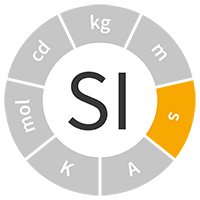 The second is used to measure time. As well as enabling us to tell the time of the day, accurate timekeeping is key to satellite navigation systems, underpins the functioning of the internet and facilitates timestamping for transactions in financial trading.
The second is used to measure time. As well as enabling us to tell the time of the day, accurate timekeeping is key to satellite navigation systems, underpins the functioning of the internet and facilitates timestamping for transactions in financial trading.
Ancient civilisations used sundials and obelisks to tell the time, which was not very precise, and was restricted in cloudy weather or at night. These methods of timekeeping were based on the daily rotation of the Earth around its own axis. However this period of rotation is not regular enough to serve as a definition for modern-day applications.
Atomic clocks, which keep time using transition energies in atoms, revolutionised timekeeping. NPL developed the first operational caesium-beam atomic clock in 1955. This clock was so accurate that it would only gain or lose one second in three hundred years. Modern atomic clocks can be as much as a million times more accurate than this, and underpin satellite technology, like GPS or the internet.
The second is defined by taking the fixed numerical value of the caesium frequency ∆ν, the unperturbed ground-state hyperfine transition frequency of the caesium 133 atom, to be 9 192 631 770 when expressed in the unit Hz, which is equal to s−1.
The wording of the definition was updated in 2019.
Satellite navigation systems determine locations using signals from atomic clocks on board satellites.
Accurate timestamping of financial transactions is important to help prevent trading irregularities and to keep an audit trail.
For thousands of years the Earth's rotation was our most stable timekeeper. However, the quartz and atomic clocks invented during the 1930s and 1950s were even better timekeepers, and showed that the Earth does not rotate steadily but "wobbles".
The atom can be pictured as a mini solar system, with the heavy nucleus at the centre surrounded by electrons in a variety of different orbits. The orbits correspond to energy levels, and electrons can only move between levels when they absorb or release just the right amount of energy.
This energy is absorbed or released in the form of electromagnetic radiation, the frequency of which depends on the difference in energy between the two levels. By measuring the frequency of the electromagnetic radiation, like counting the number of pendulum swings, we can measure the passage of time.
Time measurement has become a basic part of everyday life and accuracies of the nearest minute or a few seconds are usually good enough for most human activities, but highly accurate timing plays a vital role in many other aspects of the modern world. The Global Positioning System (GPS) satellites broadcast timing signals from onboard atomic clocks, which enable land vehicles, shipping and aircraft to know their location within a few metres.
Clocks for the 21st century based on single cold trapped ions or collections of atoms are being developed. Ions are charged atoms which can be trapped almost indefinitely by electromagnetic fields, and cooled by laser beam close to absolute zero. In this way, certain optical absorptions in the ion can exhibit a very pure frequency. This can also be achieved for atoms trapped by intersecting light beams.
At NPL, optical clocks are being developed which target accuracies of around 100 times higher than the best current microwave frequency atomic clocks. That is equivalent to losing or gaining no more than one second in the age of the universe.